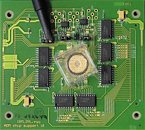- Joined
- May 14, 2004
- Messages
- 27,965 (3.71/day)
| Processor | Ryzen 7 5700X |
|---|---|
| Memory | 48 GB |
| Video Card(s) | RTX 4080 |
| Storage | 2x HDD RAID 1, 3x M.2 NVMe |
| Display(s) | 30" 2560x1600 + 19" 1280x1024 |
| Software | Windows 10 64-bit |
Researchers at IBM Zurich and Germany University of RTWH Aachen have developed a new non-volatile phase change memory with monoatomic glassy antimony, which unlike conventional phase-change-materials uses just a single element: antimony (Sb). Traditional phase-change memories use a mix of different materials, which makes things complicated when you try to shrink them down for higher storage densities, as impurities and composition differences negatively affect yields.
The novel approach is based on pure antimony films that are between 3 and 10 nanometers thick, confined between Silicon layers of 40-200 nm thickness. For their prototypes the engineers achieved a switching rate of 50 nanoseconds (20 MHz). While this doesn't sound very fast, the researchers are optimistic that this can be optimized further, their next goal is 10 nanoseconds, which is getting in the region of DRAM speeds.

Previous experiments with single-element phase-change-memory were mildly successful, having to be created carefully in thin films. Their new method uses ultra-fast cooling of the material coming out of the melt, to instantly turn it into glass, which has the desired properties. Now they apply current through some contacting structures to heat the material. By carefully controlling timing and current it becomes possible to switch the material between an electrically conducting and non-conducting state, which can be used to store a single bit of information. Unlike traditional DRAM memory, a permanent voltage supply is not required, since the material physically changes its properties, and doesn't just store a volatile electron, that needs to be refreshed from time to time.

For mass production, the biggest hurdle is the limited lifetime of the antimony glass state. At 60-70°C, which is a typical operating temperature for consumer electronics devices, that turned out to be just 100 seconds. The researchers seem confident that this can be improved, possibly by adjusting the film's thickness, using 3D structures or using better confinement materials, that might not even be silicon anymore.
View at TechPowerUp Main Site
The novel approach is based on pure antimony films that are between 3 and 10 nanometers thick, confined between Silicon layers of 40-200 nm thickness. For their prototypes the engineers achieved a switching rate of 50 nanoseconds (20 MHz). While this doesn't sound very fast, the researchers are optimistic that this can be optimized further, their next goal is 10 nanoseconds, which is getting in the region of DRAM speeds.

Previous experiments with single-element phase-change-memory were mildly successful, having to be created carefully in thin films. Their new method uses ultra-fast cooling of the material coming out of the melt, to instantly turn it into glass, which has the desired properties. Now they apply current through some contacting structures to heat the material. By carefully controlling timing and current it becomes possible to switch the material between an electrically conducting and non-conducting state, which can be used to store a single bit of information. Unlike traditional DRAM memory, a permanent voltage supply is not required, since the material physically changes its properties, and doesn't just store a volatile electron, that needs to be refreshed from time to time.

For mass production, the biggest hurdle is the limited lifetime of the antimony glass state. At 60-70°C, which is a typical operating temperature for consumer electronics devices, that turned out to be just 100 seconds. The researchers seem confident that this can be improved, possibly by adjusting the film's thickness, using 3D structures or using better confinement materials, that might not even be silicon anymore.
View at TechPowerUp Main Site



